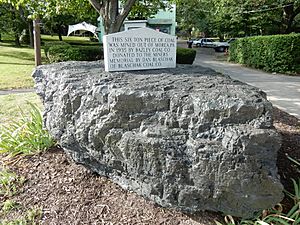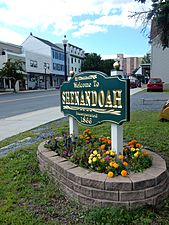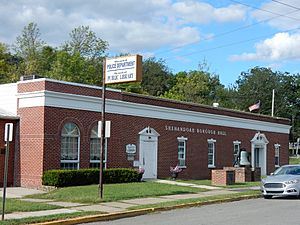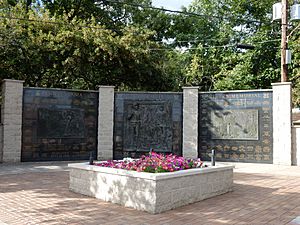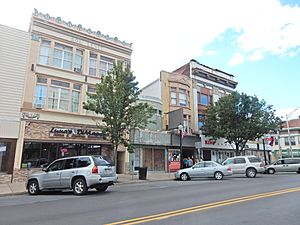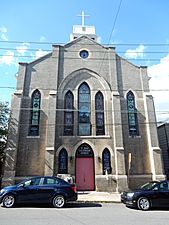Shenandoah, Pennsylvania facts for kids
Quick facts for kids
Shenandoah, Pennsylvania
|
||
|---|---|---|
|
Borough
|
||
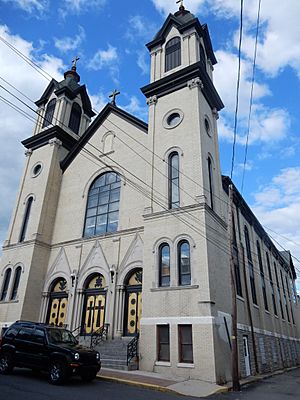
St. Casimir's Catholic Church in Shenandoah
|
||
|
||
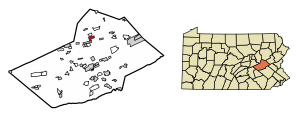
Location of Shenandoah in Schuylkill County, Pennsylvania.
|
||
| Country | United States | |
| State | Pennsylvania | |
| County | Schuylkill | |
| Settled | 1820 | |
| Incorporated | 1866 | |
| Government | ||
| • Type | Borough Council | |
| Area | ||
| • Total | 1.58 sq mi (4.09 km2) | |
| • Land | 1.51 sq mi (3.91 km2) | |
| • Water | 0.07 sq mi (0.17 km2) | |
| Population
(2020)
|
||
| • Total | 4,249 |
|
| • Estimate
(2021)
|
4,247 | |
| • Density | 3,150.23/sq mi (1,216.46/km2) | |
| Time zone | UTC-5 (Eastern (EST)) | |
| • Summer (DST) | UTC-4 (EDT) | |
| ZIP code |
17976
|
|
| Area code(s) | 570 | |
| FIPS code | 42-70056 | |
| Website | http://shenandoahpa.org/ | |
Shenandoah is a small town, called a borough, located in Schuylkill County, Pennsylvania. It is part of the Coal Region, an area known for its coal mines. Shenandoah is different from Shenandoah Heights, which is a nearby community. In 2021, about 4,247 people lived in Shenandoah.
The borough is about 53.5 miles northwest of Allentown. It is also about 102.3 miles northwest of Philadelphia. New York City is about 144.5 miles to the west.
Contents
Exploring Shenandoah's Past
The land where Shenandoah now stands was first settled in 1835 by a farmer named Peter Kehley. He cleared some land and built a log cabin. He lived there alone for about 20 years.
Later, the Philadelphia Land Company bought his land. They expected coal mines to open in the area. So, in 1862, they planned out the town.
Growth from Coal Mining
Shenandoah grew very quickly during the Civil War. This was because several anthracite coal mines were developed and opened. The area officially became a borough in 1866. It was a busy place during the time of the Molly Maguires in the 1870s.
After the first settlers from England, Wales, Ireland, and Germany, many new people arrived. These immigrants came from central, eastern, and southern European countries. People from Poland, Lithuania, and Italy moved to Shenandoah around the early 1900s.
Shenandoah was unique because three different railroad companies served it. The Lehigh Valley Railroad Station was the main place for passengers. The town also had service from the Pennsylvania Railroad and the Reading Railroad. This made Shenandoah the only borough in Pennsylvania with three railroad companies.
In 1902, Shenandoah was known for having many bars and breweries. It was said to have more bars per thousand people than any other place in the world.
During the Great Coal Strike of 1902, the Pennsylvania National Guard came to Shenandoah. They helped keep peace during the strike. The strike ended after President Theodore Roosevelt got involved.
By 1920, nearly 30,000 people lived in Shenandoah. However, after World War II, the coal industry began to decline. Many coal miners left Shenandoah to find work in other places.
The story of Shenandoah, the coal industry, and the Molly Maguires was written about. George Leighton included these topics in his 1939 book, Five Cities: The Story of Their Youth and Old Age.
Understanding the Name Shenandoah
The exact meaning of the name Shenandoah is not fully known. One idea is that it comes from an Indian word. This word might mean 'sprucy stream' or 'river flowing alongside high hills and mountains'.
Another idea is that the town was named after the Shenandoah Valley in Virginia. That valley's name comes from an Iroquoian word. This word means 'deer'.
Shenandoah's Location and Climate
Shenandoah is located at coordinates 40.819753 degrees North and -76.202883 degrees West.
The borough covers about 1.6 square miles. Most of this area, about 1.5 square miles, is land. A small part, about 0.1 square miles, is water.
Shenandoah has a warm-summer humid continental climate. This means it has warm summers and cold winters. Average monthly temperatures range from 25.0 degrees Fahrenheit in January to 69.5 degrees Fahrenheit in July. The area's hardiness zone is 6a, which helps gardeners know what plants can grow there.
Who Lives in Shenandoah?
The population of Shenandoah has changed over the years. In 2000, there were 5,624 people living in the borough. By 2010, the population was 5,071. The most recent census in 2020 counted 4,249 people.
Diversity in Shenandoah
Shenandoah is a diverse community. In 2020, about 62.79% of residents were non-Hispanic White. About 2.97% were Black or African American. A significant portion, 32.22%, identified as Hispanic or Latino. Many people in Shenandoah speak a language other than English at home. About 33.3% of residents do, with 30.2% speaking Spanish.
Age and Income
The community has a mix of age groups. About 30.43% of the population is younger than 20 years old. The median age in Shenandoah is 32.9 years.
The median income for a household in Shenandoah was $40,435. For families, it was $42,245. However, the poverty rate in Shenandoah is higher than in Pennsylvania generally. About 30.6% of the population lives below the poverty line. This includes 51.0% of those under age 18.
| Historical population | |||
|---|---|---|---|
| Census | Pop. | %± | |
| 1870 | 2,951 | — | |
| 1880 | 10,147 | 243.8% | |
| 1890 | 15,944 | 57.1% | |
| 1900 | 20,321 | 27.5% | |
| 1910 | 25,774 | 26.8% | |
| 1920 | 24,726 | −4.1% | |
| 1930 | 21,782 | −11.9% | |
| 1940 | 19,790 | −9.1% | |
| 1950 | 15,704 | −20.6% | |
| 1960 | 11,073 | −29.5% | |
| 1970 | 8,287 | −25.2% | |
| 1980 | 7,589 | −8.4% | |
| 1990 | 6,221 | −18.0% | |
| 2000 | 5,624 | −9.6% | |
| 2010 | 5,071 | −9.8% | |
| 2020 | 4,249 | −16.2% | |
| 2021 (est.) | 4,247 | −16.2% | |
| Sources: | |||
Famous People from Shenandoah
Many notable people have come from Shenandoah:
- Joseph Awad – A poet, painter, and public relations expert.
- Al Babartsky – A college and professional American football player.
- Francis Brennan – The first American to be appointed to the Roman Curia, a part of the Catholic Church's administration.
- Walter Ciszek – A Jesuit priest who survived the Russian GULAG.
- Anthony P. Damato – A United States Marine and Medal of Honor recipient. A Navy ship was named after him.
- John Morgan Davis – He served as Lieutenant Governor of Pennsylvania.
- Jimmy Dorsey and Tommy Dorsey – Famous jazz musicians and bandleaders.
- Herschel Levit – A professor, artist, designer, and author.
- Nicholas Marsicano – A painter and teacher of the New York School of art.
- Mary Joan Nielubowicz – A Rear Admiral and Director of the United States Navy Nurse Corps.
- Darryl Ponicsan – An author and screenwriter known for films like The Last Detail.
- Abner Charles Powell – A professional baseball player, manager, and innovator.
- Jerry Wolman – A former owner of the Philadelphia Eagles (NFL) and Philadelphia Flyers (NHL).
- Nellie King – A MLB pitcher and broadcaster for the Pittsburgh Pirates.
- Ted Twardzik – The founder of Mrs. T's Pierogies.
- Tim Twardzik – A State Representative for Pennsylvania and co-owner of Mrs. T’s Pierogies.
Local News and Entertainment
Shenandoah has several local media sources:
- The Pottsville Republican – Herald is a daily newspaper.
- The Hazleton Standard-Speaker is another daily newspaper.
- WCDH 91.5FM is a radio station licensed to Shenandoah, playing Contemporary Christian music.
- WMBT 1530 on the AM dial served the community from 1963 to 2003.
- The Shenandoah Sentinel is an online local newspaper.
Schools in Shenandoah
The school district that serves Shenandoah is the Shenandoah Valley School District.
Churches in Shenandoah
Shenandoah is home to several historic churches:
- St. Michael Greek Catholic Church (Ruthenian Catholic Church) was the first church of its kind in the United States. It was dedicated in 1886.
- St. George Lithuanian Roman Catholic Church is the oldest Lithuanian parish in the United States. It was established in 1872, and the church building was completed in 1891.
- St. Casimir Roman Catholic Church is one of the oldest Polish parishes in the United States.
Gallery
Images for kids
See also
 In Spanish: Shenandoah (Pensilvania) para niños
In Spanish: Shenandoah (Pensilvania) para niños





